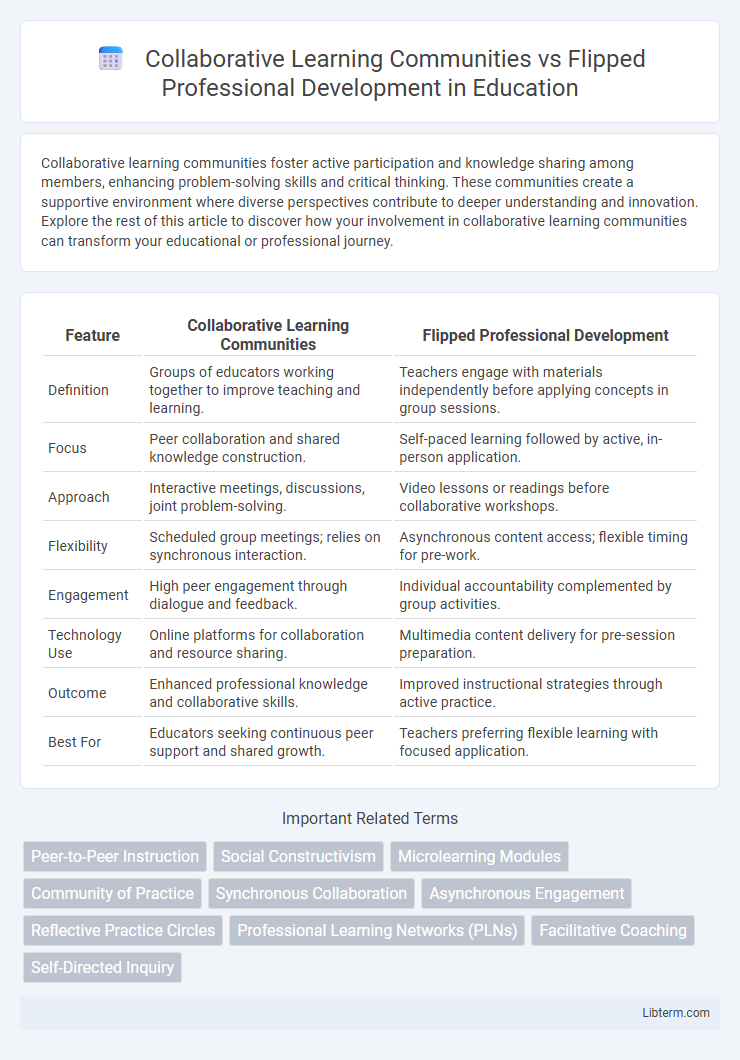Collaborative learning communities foster active participation and knowledge sharing among members, enhancing problem-solving skills and critical thinking. These communities create a supportive environment where diverse perspectives contribute to deeper understanding and innovation. Explore the rest of this article to discover how your involvement in collaborative learning communities can transform your educational or professional journey.
Table of Comparison
| Feature | Collaborative Learning Communities | Flipped Professional Development |
|---|---|---|
| Definition | Groups of educators working together to improve teaching and learning. | Teachers engage with materials independently before applying concepts in group sessions. |
| Focus | Peer collaboration and shared knowledge construction. | Self-paced learning followed by active, in-person application. |
| Approach | Interactive meetings, discussions, joint problem-solving. | Video lessons or readings before collaborative workshops. |
| Flexibility | Scheduled group meetings; relies on synchronous interaction. | Asynchronous content access; flexible timing for pre-work. |
| Engagement | High peer engagement through dialogue and feedback. | Individual accountability complemented by group activities. |
| Technology Use | Online platforms for collaboration and resource sharing. | Multimedia content delivery for pre-session preparation. |
| Outcome | Enhanced professional knowledge and collaborative skills. | Improved instructional strategies through active practice. |
| Best For | Educators seeking continuous peer support and shared growth. | Teachers preferring flexible learning with focused application. |
Understanding Collaborative Learning Communities
Collaborative Learning Communities (CLCs) emphasize peer interaction and shared knowledge construction to enhance professional growth and instructional practices. CLCs foster sustained dialogue, collective problem-solving, and the exchange of diverse perspectives, creating a supportive environment for continuous learning. Understanding the dynamics of trust, mutual respect, and accountability within CLCs is essential for maximizing their impact on teacher efficacy and student achievement.
The Fundamentals of Flipped Professional Development
Flipped Professional Development fundamentally shifts traditional training by delivering instructional content asynchronously, allowing educators to engage with material at their own pace before collaborative, in-person sessions focus on application and practice. This approach leverages multimedia resources and pre-session assignments to maximize active learning and peer collaboration during face-to-face meetings. Emphasizing flexibility and educator autonomy, Flipped PD enhances skill acquisition and promotes reflective practice compared to conventional Collaborative Learning Communities that center primarily on synchronous group interactions.
Comparing Core Principles: Collaboration vs. Individual Preparation
Collaborative Learning Communities emphasize shared knowledge construction through group interaction, fostering collective problem-solving and peer support. Flipped Professional Development centers on individual preparation where educators engage with instructional content independently before applying concepts collaboratively in practice. Both approaches aim to enhance professional growth but differ in prioritizing either real-time collaboration or self-paced learning for skill acquisition.
Benefits of Collaborative Learning in Professional Growth
Collaborative learning communities foster continuous professional growth by encouraging shared knowledge, peer feedback, and diverse perspectives, which enhance problem-solving skills and innovation. These communities build strong networks that support collective goal setting and accountability, leading to improved instructional practices and student outcomes. Engaging in collaborative learning also increases teacher motivation and confidence through regular, meaningful interactions and professional support.
Advantages of the Flipped Approach in Teacher Development
The flipped professional development model empowers teachers to engage with instructional content at their own pace, enhancing understanding and retention through personalized learning. It maximizes in-person sessions for active collaboration, problem-solving, and practical application of strategies, leading to more effective skill acquisition. This approach fosters deeper reflection and continuous improvement compared to traditional collaborative learning communities, which often rely heavily on synchronous meetings with limited flexibility.
Challenges Faced by Each Professional Development Model
Collaborative Learning Communities face challenges such as uneven participation among members, difficulty sustaining engagement over time, and managing diverse perspectives that can hinder consensus building. Flipped Professional Development encounters obstacles including learners' varying access to technology, resistance to self-directed learning, and the need for substantial upfront preparation to create effective pre-session materials. Both models require strategic planning to address these challenges and ensure meaningful and inclusive professional growth.
Technology’s Role in Collaborative and Flipped Learning
Technology plays a pivotal role in both Collaborative Learning Communities and Flipped Professional Development by enabling seamless communication and resource sharing through platforms like Microsoft Teams, Google Workspace, and Zoom. In Collaborative Learning Communities, digital tools support real-time collaboration, data sharing, and reflection, fostering continuous peer feedback and collective problem-solving. Flipped Professional Development leverages video conferencing and learning management systems such as Canvas or Moodle to deliver asynchronous content, allowing educators to engage with material at their own pace and participate in interactive virtual sessions that enhance knowledge application.
Facilitator and Participant Roles: Key Differences
Collaborative Learning Communities involve facilitators acting primarily as guides who nurture peer-to-peer interaction, while participants engage actively in shared problem-solving and knowledge exchange. In contrast, Flipped Professional Development positions facilitators as content curators who provide pre-session materials, enabling participants to self-prepare and dedicate live sessions to applying concepts and personalized feedback. The key difference lies in the facilitator's shift from interactive co-learner in Collaborative Learning Communities to resource provider in Flipped Professional Development, shaping distinct participant roles of collective collaboration versus independent preparation.
Measuring Impact: Outcomes and Success Metrics
Collaborative Learning Communities (CLCs) demonstrate increased teacher engagement and sustained knowledge retention through peer interactions and shared problem-solving, with success metrics including improved student performance, teacher collaboration frequency, and qualitative feedback. Flipped Professional Development (FPD) emphasizes flexibility and individualized pacing, measuring impact via completion rates, pre- and post-assessment scores, and application of skills in classroom settings. Comparing outcomes, CLCs often show stronger community building and ongoing support, while FPD provides scalable content delivery with measurable knowledge gains.
Choosing the Right Model: Factors for Effective PD Implementation
Choosing the right professional development (PD) model depends on factors such as organizational culture, participant engagement, and resource availability. Collaborative Learning Communities foster peer interaction and shared problem-solving, enhancing practical application and sustained support. Flipped Professional Development emphasizes pre-session content review and active in-person activities, ideal for flexible schedules but requires reliable technology and motivated learners.
Collaborative Learning Communities Infographic

 libterm.com
libterm.com